Patrick K. Sullivan, M.D., F.A.C.S.
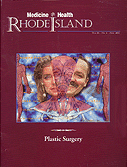
As seen in Medicine and Health / Rhode Island
magazine, Vol. 84, No. 4, April 2001.
Art and Science
Though anatomy and advanced surgical techniques are absolutely key, artistry and the artistic appreciation of female and male faces is of primary importance in achieving an optimal result. While this does not detract from the importance of surgical skill, plastic surgery of the face involves far more than science.
Why Cosmetic Surgery?
Rhode Island physicians have long been providing sophisticated medical care to their patients, and thus our residents of Southern New England are living healthier and longer lives. Productive years have increased both through working and socializing. Rhode Island physicians also have long encouraged their patients to stop smoking, eat healthier diets and exercise. Many patients have truly listened and changed their lifestyles for the better.
However, with people living longer, fuller lives, some feel that their warm, energetic internal spirit does not match their external, and visibly aging, appearance. They feel much younger than their chronological age. When they look in the mirror or note the way others may react to them, they sense an incredible mismatch.
Case 1 |
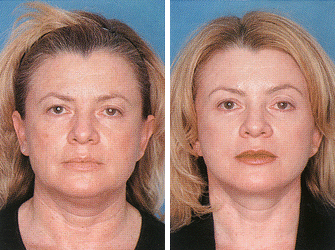 |
| Figure 1 Figure 2 |
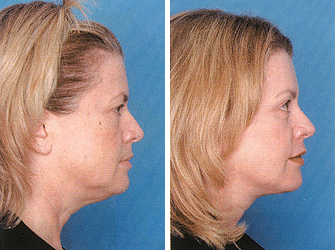 |
| Figure 3 Figure 4 |
|
This 50 year old woman wanted her appearance to reflect the energetic self that she felt on the inside. A lifting sculpting procedure was done for her upper face (endoscopically), the midface, jaw line and neck. Fat was removed from the jowls and neck; and using liposculpture, fat was placed in the lips and nasolabial folds. She chose not to have her eyelid ptosis addressed. |
How Can Cosmetic Surgery Enhance One’s Life?
“People tell me I look tired when I am not. Appearing tired and/or sad when one does not feel that way is a huge disadvantage. Individuals who look tired at work may not be perceived by their superiors as hard-working innovators who should be promoted. They may not be seen as energetic leaders who can take their companies into the Internet computer age.
People who look tired and sad may not be approached socially as readily or as often as someone who appears energetic and happy. Of course, we cannot smile all of the time, so when our faces are relaxed, the lines between the eyebrows look like frown lines. The jowls, sagging skin of face and neck and the downturned appearance of the corners of the mouth may look sad.
| Table 1
Distracting features that can be addressed.
|
Sagging skin over the eyes not only makes people’s faces look tired and sad, but may also impair one’s ability to communicate as accurately and effectively with their eyes. Thus, nonverbal cues may be misinterpreted.
A drawn appearance of the face can be the result of tissue falling through the loss of skin elasticity from age, the sun, smoking and other environmentally mediated factors. Loss of fat from certain areas of the face also leads to both a drawn and also an unhealthy appearance.
Genetics also plays a key role in aging, and we have seen genetic factors cause dramatic premature aging. Fortunately, all of this can be addressed with advanced facial rejuvenation treatments.
| Case 2 |
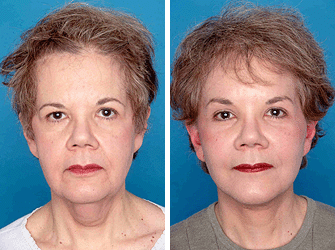 |
| Figure 5Â Â Â Â Â Â Â Â Â Â Â Â Â Â Â Â Â Â Â Â Â Â Â Â Â Â Â Â Â Â Â Â Â Â Â Â Figure 6 |
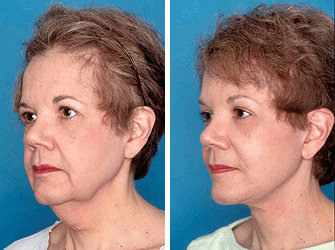 |
| Figure 7Â Â Â Â Â Â Â Â Â Â Â Â Â Â Â Â Â Â Â Â Â Â Â Â Â Â Â Â Â Â Â Â Â Â Â Â Â Â Â Â Figure 8 |
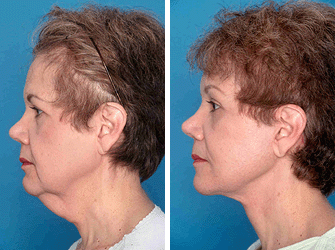 |
| Figure 9Â Â Â Â Â Â Â Â Â Â Â Â Â Â Â Â Â Â Â Â Â Â Â Â Â Â Â Â Â Â Â Â Â Â Â Â Â Â Â Figure 10 |
| This 60 year old woman was concerned about face and neck laxity along with deep facial folds and wrinkles. She also noted a hooded appearance of her upper eyelid region. Both eyebrows had fallen and her right eyebrow was significantly lower than her left.
She was treated with endoscopic forehead rejuvenation via small incisions in the scalp. This lifted the tissue of the eyebrow and eyelid region making her eyes and eyelids more visible and symmetric. Lifting and sculpting was done of the mid face, lower face and neck region. Fat was removed from areas of the jowls and neck. Fat injections were placed in the nasolabial fold, areas around her mouth and lips. The Patient’s PerspectivePeople…stop me and want to know if I have lost weight. Yes, lost weight, but that was months before Dr. Sullivan created the “new me.” Now my face is in proportion with my body, and I look (at least) ten years younger than my actual age. I gave myself a “special (60th) birthday present” last February; I had a facial rejuvenation. To be honest, I do not remember any pain, perhaps some mild discomfort for a very short time. Knowing then what I know now, would I have had the procedure? You bet I would! I look younger, very natural, and do not mind looking in any mirror. Dr. Sullivan made me look like I feel! |
Who is a Candidate?
Good candidates for cosmetic surgery are healthy, well adjusted people who want to maximize their productivity, socialize with confidence and live life to the fullest.
How Can Physicians Decrease Risk?
We are indebted to our colleagues for working with us to prepare their patients for cosmetic surgery and making sure that they are as healthy as possible. Safety is our primary goal. Thus, we request that our patients go to their primary care doctor for a preoperative evaluation. We also request that their physicians assist us in helping do everything possible perioperatively to assure the patient’s safety. For example, we strive to have the patient’s blood pressure as close to normal as possible. We also want to assure that cardiac function is optimal. Both primary- care physicians and cardiologists may be involved. I have had cardiologists refer patients to me for face-lifting and sculpting procedures who have even had bypass surgery. Together, we work out an ideal plan for a procedure that is appropriate for the patient.
Increasing Safety
Optimal Monitoring
Our patients are constantly cared for and monitored by a physician, anesthesiologist or an anesthetist while in the operating room. This has led to a very low risk situation. It does add significantly to the cost of the procedure, but this investment is well worth it.
Anesthesia Care
Monitored intravenous sedation, not general anesthesia, is the method used in more than 95% of patients. No paralytic agents are used and no intubation is needed; thus when the procedure is finished, the patient characteristically sits up, gets off the table and steps into a chair.
Surgical Care
Facial nerves, both motor and sensory, are of great significance as they are in the surgical field. Our studies at Brown University and at Johns Hopkins Medical Center reveal marked variability of facial nerve location.1 However, there are characteristic safe planes in which we can work without any permanent injury, as we have previously reported.2 This continues to be the case. With a more comprehensive approach to facial rejuvenation, we are now restoring areas that may not have been previously addressed. In an effort to obtain normal sensation to the entire face as soon as possible, we continue to study the complex sensory nerves. We also have found great variability in nerve dominance and distribution.3
Privacy and Confidentiality
Finally, we have achieved the type of privacy frequently desired in New England. A private reception area is available upon request to ensure our patients will not encounter friends and neighbors with whom they may not want to interact in our office. Though our private operating rooms are in close proximity to the hospital, our patients’ surgery can be kept confidential. Their recovery can be in a special private area of the hospital, if desired, with a private duty nurse. They also can recover in one of our local or regional beautiful hotels, with or without our private duty nurses.
Surgery Performed Locally
Having one’s cosmetic surgery in Rhode Island has many advantages. Patients are close to their primary-care doctor, should a consultation be desired. The patient’s surgeon is more immediately available to follow the patient throughout his or her own unique recovery. This then will allow optimal timing for suture removal and also guide the patient in appropriate activity levels, given his or her unique rate of healing. Patients find that special postoperative care given in their surgeon’s office can help them feel and look better faster. This includes the evolving make-up cosmetic needs and scheduled instructional sessions by our specialized aesthetician.
Lymphatic facial massages also are continued for weeks postoperatively as the internal healing process is often slow. Though this healing process cannot be rushed, we can work to decrease the natural swelling that comes with surgery.
Cosmetic Surgery for Signs of Aging
Early signs of aging may be seen more in certain locations of the face. The lower eyelids, for example, can become puffy early in life. This is frequently a hereditary trait, which can be treated with atransconjunctival lower lid blepharoplasty that alleviates the problem and leaves no external scar.
Aging also is evident in the forehead and brow region with frown lines, deep wrinkles and laxity that causes tissue to fall and collect over the upper eyelids. This laxity can easily be misdiagnosed as excessive eyelid skin and be inappropriately treated with removal of too much of this precious skin. However, optimal treatment is to bring the lax lateral forehead tissue and brow tissue back into a more normal position. In this case, less skin, and sometimes even no eyelid skin, needs to be removed.
Key features of state-of-the art forehead rejuvenation frequently involve the use of an endoscopic technique with incisions being remarkably small, yet the technique is very effective in artistically designing the eyebrow position to give a natural, well-rested appearance. We have found in the laboratory the presence of retaining ligaments of the forehead, which enable us to artistically design the brow to achieve optimal position and soften the frown lines at the same time.
Why Treat the Whole Face and Neck?
The aging process also frequently involves more global changes, as previously discussed (Figures 1,3,5,7,9,11). Treating just one area may draw attention to the untreated areas of the face and leave an artistic mismatch. Thus, the upper face is assessed to determine the proper forehead height and position. The midface, lower face and neck are treated to lift and sculpt vertically in a deeper level. Then, as the reshaping is being done, the skin is very carefully placed in a natural position based on factors that appear most artistically pleasing.
The neck banding frequently referred to by our patients as “turkey neck” is often a combination of platysma muscle abnormalities combined with skin laxity. Excessive fat may play a role, but liposuction alone is usually suboptimal because of the accompanying muscle and skin abnormalities. Facial sculpting is frequently enhanced with liposculpture. This involves carefully harvesting fat from another area of the body, special preparation of the live fat cells and then placing this fat in the deficient areas of the face. Fine cannula introducers allow the fat to be placed in threads surrounded by well-vascularized facial soft tissue that keeps the fat alive. This also helps with filling deep nasolabial folds, lip enhancement and other areas where fat has been lost from the face as part of the aging process.
A wide variety of non-surgical treatments also are used to help with the face and neck rejuvenation process. These include a selection of skin peels, microdermabrasion, dermatophoresis, and other methods of skin care to help clean, protect and enhance the skin’s health and appearance. Botox injections also are used to soften frown lines and wrinkles through the modulation of muscle activity. Both surgical and non-surgical treatments can frequently be offered to patients to help meet their individual needs.
Summary
Our objective is to present an overall, customized treatment plan for the patient to address his or her concerns in the most comprehensive way possible. We then allow the patient to choose if he or she would like to have this done with one procedure and one recovery period. This one treatment may put the patient far enough ahead of the aging curve that they may never desire another surgery.
The patient could also choose to have the surgery broken up into multiple treatments in a more piecemeal fashion. This would necessitate multiple recovery periods and during the intervening time, there may be an artistic mismatch between the rejuvenated area that has been treated and adjacent untreated areas that still manifest all the signs of the aging process. The choice is left to the patient.
References
- Falcone P, Sullivan PK, Marler J. Avoiding Facial Nerve Damage in Deep Plane Rhytidectomy: An Anatomic Study. American Society of Aesthetic Plastic Surgery, New York, New York. April 1991
- Sullivan PK, Falcone P. Anatomy and Preservation of the Facial Nerve in Aesthetic and Reconstructive Plastic Surgery. New England Society of Plastic and Reconstructive Surgeons, Newport, RI. June 1993
- Pantaloni M, Sullivan PK. Relevance of the lesser occipital nerve and facial rejuvenation surgery. Plastic Reconstruct Surg June 2000.
- Salomon J, Sullivan PK. Retaining Ligaments in the Forehead: Their Importance During Forehead Rejuvenation American Society of Plastic Surgeons, Annual Meeting, Dallas,TX. November 1996
- Sullivan PK. Adjunct Face-lifting Procedures. North England Society of Plastic Surgeons, Annual Scientific Meeting, Newport, RI. June 1999.
- Sullivan PK, Salomon J. Forehead Rejuvenation: Treatment of Asymmetric eyebrows. Seventh Congress of Italian and American Plastic Surgeons, Newport RI. June 2000.
Patrick K Sullivan MD, is Associate Professor of Plastic Surgery, Brown Medical School.
